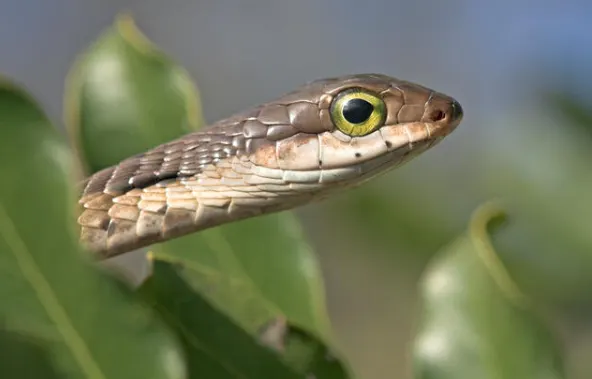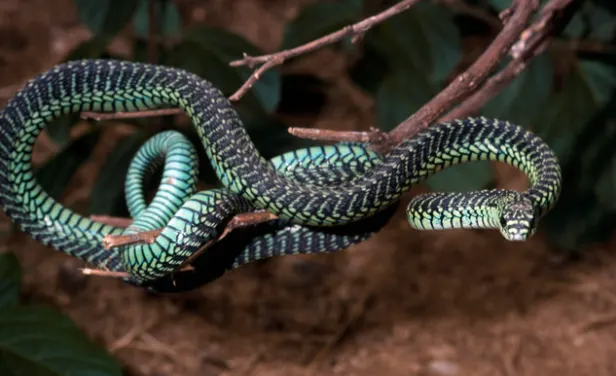The boomslang, with its vibrant colors and intriguing behavior, is one of Africa’s most fascinating reptiles. This rear-fanged, venomous snake is primarily arboreal, spending most of its life in trees, blending seamlessly with the foliage. The name “boomslang” comes from the Afrikaans words for “tree” (boom) and “snake” (slang), highlighting its tree-dwelling nature. Despite its fearsome reputation, the boomslang is typically shy and prefers to avoid human interaction.

Table of Contents
A Closer Look at the Boomslang
Scientific Classification:
- Kingdom: Animalia
- Phylum: Chordata
- Class: Reptilia
- Order: Squamata
- Family: Colubridae
- Genus: Dispholidus
- Species: Dispholidus typus
Conservation Status: Least Concern
Lifespan: 8-9 years in captivity
Venomous: Yes
Diet: Omnivore (reptiles, frogs, birds, eggs, and small mammals)
Fascinating Facts About the Boomslang
- Chemical Detection: Although the boomslang has a poor sense of smell, it can detect chemical cues in the air by flicking its tongue and pressing it against sensory organs in its mouth.
- Deadly Bite: Noted herpetologist Karl Patterson Schmidt tragically died from a boomslang bite in 1957 after mistakenly believing it wouldn’t be fatal.
- Retractable Fangs: The boomslang can fold its fangs back into its mouth when they are not in use.
- Egg-Laying: Female boomslangs lay 8-27 eggs in hollow tree trunks or rotting logs, close to the ground.
- Brumation: In colder months, the boomslang enters a state of dormancy called brumation, often in bird nests, where it can go long periods without
food .
Habitat and Distribution
Boomslangs are native to sub-Saharan Africa and are commonly found in countries like Swaziland, Namibia, Zimbabwe, and Mozambique. These snakes inhabit wooded grasslands and lowland forests, where they spend most of their time moving between the branches of trees. They require plenty of sunlight to maintain their body temperature and generally stay close to trees, even when they descend to the ground.
Physical Characteristics
Boomslangs are slender, measuring between 3 to 6 feet in length, with large eyes and an egg-shaped head. Males are typically bright green with black or blue outlines on their scales, while females are usually brown or dark gray with a brownish belly. Juveniles are born with gray skin, yellow throats, and black spots, only achieving adult coloration upon maturity. These color patterns are vital for camouflage in their natural environment.
The Boomslang’s Venom
Boomslangs are rear-fanged, and their venom is highly potent, attacking the circulatory system and inhibiting the body’s ability to clot blood. Though their venom is slow-acting, untreated bites can be fatal due to internal and external bleeding. However, these snakes are generally not aggressive towards humans and will only bite if they feel threatened or are handled.
Behavior and Interaction with Humans
Despite their toxic venom, boomslangs are not typically aggressive. They prefer to stay hidden in trees and only strike when provoked. The snake’s venom works slowly, allowing ample time for victims to seek medical attention. With proper treatment, most people recover without long-term effects.

Q&A Section: Common Questions About the Boomslang
Q: What is a boomslang?
A: The boomslang is a rear-fanged venomous snake native to sub-Saharan Africa. It is known for its striking green or brown skin and is primarily arboreal, meaning it lives mostly in trees.
Q: Are boomslangs venomous?
A: Yes, boomslangs are highly venomous. Their venom disrupts blood clotting and can be fatal if not treated promptly.
Q: How does a boomslang hunt?
A: Boomslangs use their camouflaged skin to blend into the trees and ambush prey, such as birds, frogs, and small mammals, with a sudden strike.
Q: Are boomslangs aggressive?
A: Boomslangs are not typically aggressive and will generally avoid humans. They only strike when they feel threatened or are handled.
Q: Where do boomslangs live?
A: Boomslangs are found in wooded grasslands and lowland forests throughout sub-Saharan Africa. They spend most of their lives in trees.
Q: What should I do if a boomslang bites me?
A: If bitten by a boomslang, seek medical attention immediately. The venom works slowly, so prompt treatment can prevent serious complications or death.
Q: Can boomslangs swim or climb walls?
A: While boomslangs can climb various surfaces and may swim for short periods, they do not typically venture near large bodies of water.
The boomslang is a remarkable example of nature’s diversity, with its unique adaptations and behavior. While it is venomous, it is also a shy and reclusive creature that plays a crucial role in its ecosystem.
- Enchi Ball Python: A Unique and Stunning Morph of Python regius - March 27, 2025
- Emerald Tree Monitor: The Enigmatic Green Guardian of the Rainforest - March 26, 2025
- The Egyptian Cobra (Naja haje): A Fascinating Serpent - March 25, 2025
